22.3: Fruits and Dispersal
- Last updated
- Save as PDF
- Page ID
- 124034
Learning Objectives
- Describe the transition from ovary and ovule to fruit and seed.
- Use characteristics of fruits, including pericarp morphology, to identify fruit type.
- Use characteristics of fruits to predict the dispersal agent for a plant's seeds.
All flowers become fruits (Figure \(\PageIndex{1}\)). This may be surprising at first, as what we culturally refer to as a fruit is a bit different than the botanical definition. Many of the "vegetables" and other plant products (e.g. grains, legumes, and nuts) that you get from the store are actually fruits! The term angiosperm refers to the fruit: angio- means vessel and sperm refers to the seed; fruits are the vessel that houses the seed or seeds. Fruits are a development of the ovary wall and sometimes other flower parts. As seeds mature, they release the hormone auxin, which stimulates the wall of the ovary to develop into the fruit. In fact, commercial fruit growers may stimulate fruit development in unpollinated flowers by applying synthetic auxin to the flower. This chapter section will cover the anatomy of a fruit, including the ovary, different fruit types, and finally, how these fruits are specialized for different dispersal mechanisms.


A fruit is defined as ripened ovary, flower, or whole inflorescence. Depending on how these parts interact to form the fruit, we can classify them into different fruit types. The pericarp (Figure \(\PageIndex{2}\)), which is comprised of the exocarp, mesocarp, and endocarp, is derived from the ovary wall.
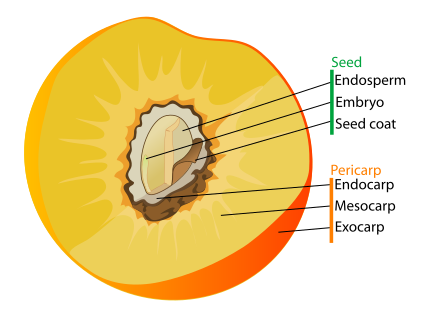
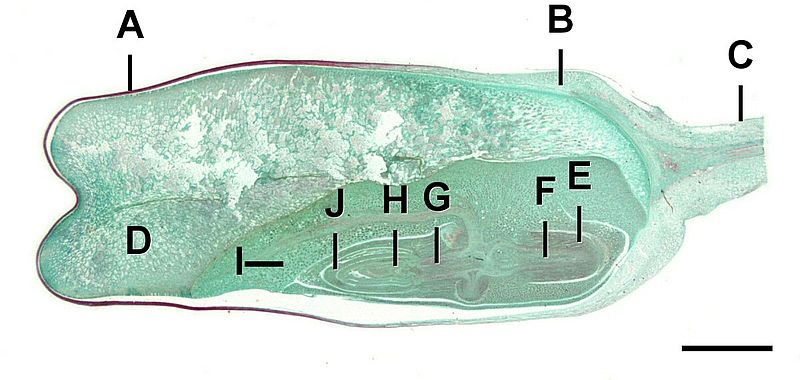
Ovary Anatomy
An unfertilized ovary, as shown in Figure \(\PageIndex{3}\), contains one or more developing ovules produced in compartments called locules. Within the ovule, the megasporangium is surrounded by tissue within the called the integument. Both of these are diploid tissues of the sporophyte. A diploid megaspore mother cell is produced within the megasporangium, which will divide by meiosis to produce the haploid megagametophyte (see Chapter 7.3.2: Angiosperm Life Cycle for a refresher). Each ovule is attached to a nutritional region of the ovary called the placenta by a strand of tissue called the funiculus. The sporophyte supports the developing ovule through this tissue pathway. Prior to fertilization, there is a small gap in the integument called the micropyle.
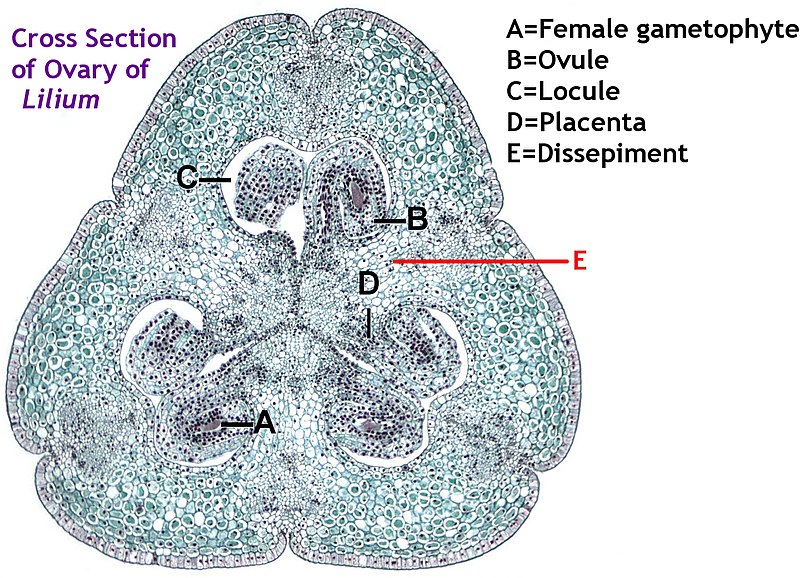
After fertilization, ovules become seeds. The micropyle closes and the integument becomes the seed coat. The megasporangium, called the nucellus, serves as nutritive tissue for the developing embryo. Angiosperms provide an additional food source to the developing zygote, the endosperm. The ovary wall develops into the pericarp.
Fruit Types
Fruits may be classified as simple, aggregate, multiple, or accessory, depending on their origin (Figure \(\PageIndex{11}\)). If the fruit develops from a single carpel or fused carpels of a single ovary, it is known as a simple fruit, as seen in nuts and beans. An aggregate fruit is one that develops from more than one carpel, but all are in the same flower: the mature carpels fuse together to form the entire fruit, as seen in the raspberry. A multiple fruit develops from an inflorescence or a cluster of flowers. An example is the pineapple, where the flowers fuse together to form the fruit.
Fruits can be dry or fleshy. An example of dry fruit is a peanut (Arachis), the shell of the peanut is the pericarp, which is dry at maturity. Examples of fleshy fruits include apples (Malus) or oranges (Citrus), where the pericarp or some other part of the floral structure becomes swollen with liquid.
Dry fruits can be further classified into dehiscent fruits, which open at maturity, or indehiscent fruits, which do not open independently. Schizocarp fruits are in between: they do not open but break into several parts (usually the distinct locules), and each part contains one seed inside. For example, maple fruit consists of two “wings”, each of them contains part of the full fruit and one seed.
In addition, fruits can be monomerous (1-seeded) like a nut or an achene, or bear multiple seeds (like the follicle in a tulip, Tulipa).
Accessory Fruits
Accessory fruits (sometimes called false fruits) are not derived from the ovary, but from another part of the flower, such as the receptacle (Figure \(\PageIndex{4}\)) or the hypanthium (Figure \(\PageIndex{5}\)).

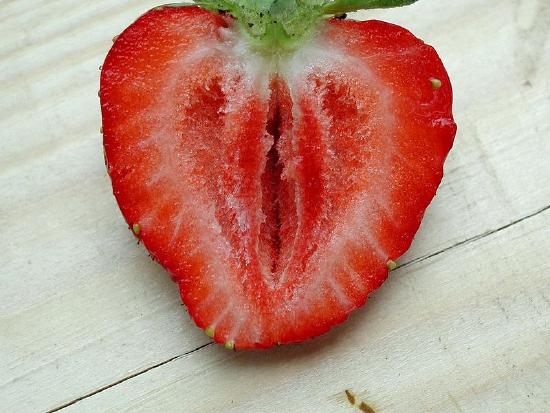
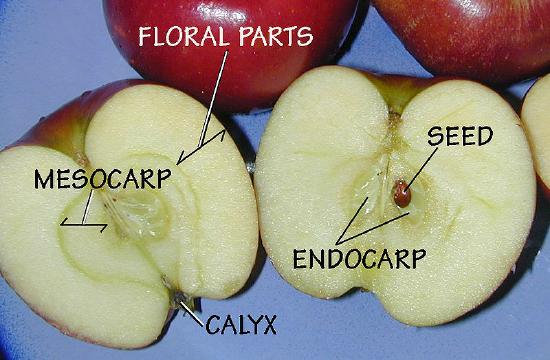
Dichotomous Key to Common Fruits
Use the following dichotomous key to identify fruit types! Note: If the fleshy part of the fruit is composed of something other than the ovary, it is an accessory fruit.
1. Fruit from one carpel of one flower ........[Simple Fruit].... 2
1. Fruit from more than one carpel or from an inflorescence .... 16
2. Fleshy at maturity ....................................... 3
2. Dry at maturity ............................................ 8
3. Thin exocarp, fleshy mesocarp, stony endocarp surrounding single, large seed ............... Drupe
3. Fruit not as described above............................................................................................... 4
4. Seeds in a linear order, separate from ovary wall, pericarp splits on two seams ...Legume (immature)
4. Fruit not as described above.................................................................................. 5
5. Papery endocarp forms a core. Derived from a perigynous flower..........Pome
5. Endocarp fleshy (not a papery core) ...................................................... 6
6. Thin exocarp, fleshy mesocarp, one to many seeds ........................... Berry
6. Exocarp thickened and leathery (modified berries) ………......... 7
7. Exocarp and mesocarp form leathery rind, locules filled with juice-filled trichomes ……...Hesperidium
7. Exocarp forms tough skin/rind, thick mesocarp, not divided into separate locules ........... Pepo
8. Dehiscent (splits open at maturity), usually many seeds ....... 9
8. Indehiscent (does not split open), usually one seeded .......... 12
9. Derived from a carpel with one locule ............................. 10
9. Derived from a carpel with more than one locule ............ 11
10. Dehiscent along one seam .......................... Follicle
10. Dehiscent along two seams ........................ Legume
11. From two locules with a central partition .............. Silique (elongate) or silicle (round)
11. From more than two locules.................................. Capsule
12. Ovary wall extends to form a wing .................. Samara
12. Fruit not winged ............................................... 13
13. Outer wall not especially thick or hard, seed small ... 14
13. Outer wall hardened, seed relatively large ................ 15
14. Seed not tightly attached to pericarp ............... Achene
14. Seed fused to pericarp, grains ........................ Caryopsis
15. Stony pericarp surrounds one large seed .............................................. Nut
15. Relatively thin exocarp, fibrous mesocarp, single large seed .............. (dry) Drupe
16. Derived from one flower with many free carpels ...... Aggregate Fruit
16. Derived from an inflorescence (many florets) ........... Multiple Fruit
Fruit and Seed Dispersal
The fruit has a single purpose: seed dispersal. Seeds contained within fruits need to be dispersed far from the mother plant, so they may find favorable and less competitive conditions in which to germinate and grow. Fruits promote the dispersal of their content of seeds in a variety of ways:
- Ballistic. Some fruits, as they dry, open explosively expelling their seeds. The pods of many legumes (e.g., wisteria) do this.
- Wind. Wind-dispersed fruit are lightweight and may have wing-like appendages that allow them to be carried by the wind. Some have a parachute-like structure to keep them afloat.
- Water. Many aquatic angiosperms and shore dwellers (e.g., the coconut palm) have floating fruits that are carried by water currents to new locations.
- Animal attachment. The cocklebur and sticktights achieve dispersal of their seeds by sticking to the coat (or clothing) of a passing animal.
- Animal ingestion. Nuts and berries entice animals to eat them. Buried and forgotten (nuts) or passing through their g.i. tract unharmed (berries), the seeds may end up some distance away from the parent plant.
All of the above mechanisms allow for seeds to be dispersed through space, much like an animal’s offspring can move to a new location. Seed dormancy allows plants to disperse their progeny through time: something animals cannot do. Dormant seeds can wait months, years, or even decades for the proper conditions for germination and propagation of the species. These dormant seeds can accumulate in the soil, forming a seed bank. Areas prone to disturbances, like fire, often rely on the seed bank to regenerate plant communities post-disturbance.
Ballistic
In ballistic dispersal, seeds are shot from the fruit. This can be accomplished via a build up of turgor pressure within the fruit (as in dwarf mistletoe and wild cucumber), a twisting action, or some other method. Watch Video \(\PageIndex{1}\) to see ballistic seed dispersal in action!
Video \(\PageIndex{1}\): Watch this fun video of different plants utilizing ballistic seed dispersal. Sourced from YouTube.
Wind
Fruits dispersed by wind, like samaras or the achenes of a dandelion, are generally winged (Figure \(\PageIndex{6}\)). In the case of a dandelion, each achene is attached to a modified calyx that forms an umbrella-like structure to catch on the wind.
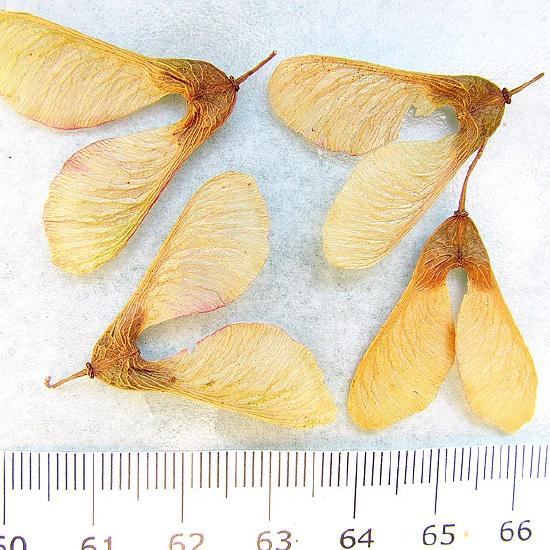
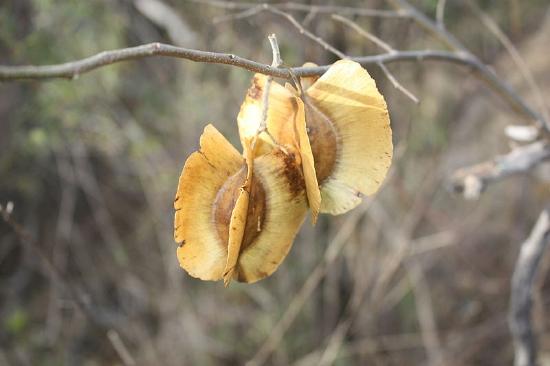
Water
Some fruits, such as those of some aquatic plants like lotus or plants adapted to island living, are specialized for water dispersal. This usually involves a buoyant pericarp, as in the fibrous husk of the water-dispersed coconut. Similarly, willow and silver birches produce lightweight fruit that can float on water. Watch Video \(\PageIndex{2}\) to see the journey of a water-dispersed sea bean.
Video \(\PageIndex{2}\): Watch this clip to see the aquatic journey of the sea bean. Toward the end of the video, be on the lookout for mangrove pneumatophores. Sourced from YouTube.
Animal Vectors
Many fruits have evolved to use animals for dispersal. Fruits with velcro-like projections or sticky pericarps latch onto mammal fur or bird feet and are transported to a new locale without needing to survive a journey through the digestive tract (Figure \(\PageIndex{7}\)). Other fruits have specialized for animal ingestion. Among these are the fruits we typically consider fruits, those that are typically sweet, fleshy, often brightly colored and intended for consumption. The seeds must either survive the digestive tract, deposited later in nutrient-rich substrate, or depend on animals who are sloppy eaters, dispersing some of the seeds as they eat others.
Some of these are highly specialized, with a single species or group of animals as the intended dispersal vector. For example, hot peppers like habañero chiles are hot because they contain a compound called capsaicin (see Figure \(\PageIndex{8}\)). They also tend to be red. This is because these peppers have specialized for bird dispersal vectors. Both birds and mammals are attracted to the color red. However, mammals often have a more thorough digestive tract, meaning seeds need more investment in protection to survive the journey. However, mammals like you and I interpret capsaicin as spicy, perhaps painful, and are often deterred by it (though many exceptions apply among humans), while birds are immune to these effects. Because of this interesting difference in physiology, some people add cayenne pepper to their suet bird feeders to keep the squirrels away.
Some animals, like squirrels, bury seed-containing fruits for later use; if the squirrel does not find its stash of fruit, and if conditions are favorable, the seeds germinate. Some birds are also known to cache nuts for later. Plants that produce nuts generally rely on this storage behavior in their animal dispersers.
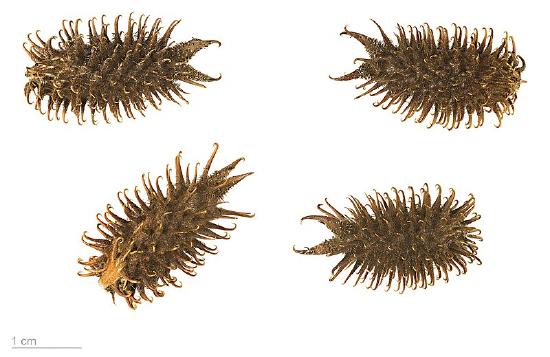

Attributions
Curated and authored by Maria Morrow using the following sources:
- 16.3D Angiosperm Life Cycle from Biology by John. W. Kimball (licensed CC-BY)
- 32.2 Pollination and Fertilization from Biology 2e by OpenStax (licensed CC-BY). Access for free at openstax.org.
- 8.2 The Flower and the Fruit from Introduction to Botany by Alexey Shipunov (public domain)


